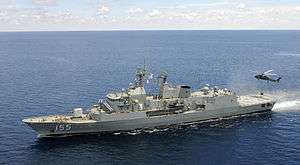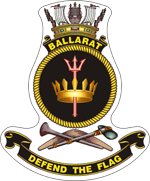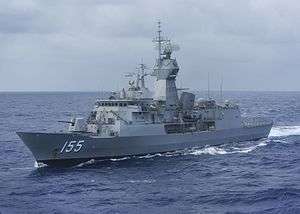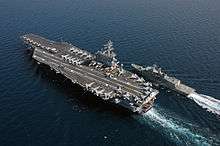HMAS Ballarat (FFH 155)
HMAS Ballarat (FFH 155) is an Anzac-class frigate of the Royal Australian Navy (RAN). The frigate was laid down in 2000 and commissioned into the RAN in mid-2004. Since entering service, Ballarat has been involved in border protection as part of Operation Relex II, was deployed to the Gulf for Operation Catalyst, and was one of the two ships involved in the Operation Northern Trident 2009 round-the-world voyage. Ballarat has undergone the Anti-Ship Missile Defence (ASMD) upgrade, completing in 2015.
 HMAS Ballarat with a US Navy helicopter in 2012 | |
| History | |
|---|---|
| Namesake: | City of Ballarat |
| Builder: | Tenix Defence Systems |
| Laid down: | 4 August 2000 |
| Launched: | 25 May 2002 |
| Commissioned: | 26 June 2004 |
| Homeport: | Fleet Base East |
| Identification: | MMSI number: 503114000 |
| Motto: | "Defend the Flag" |
| Honours and awards: | Three inherited battle honours |
| Status: | Active as of 2019 |
| Badge: |
 |
| General characteristics | |
| Class and type: | Anzac-class frigate |
| Displacement: | 3,810 tonnes full load |
| Length: | 118 m (387 ft) |
| Beam: | 15 m (49 ft) |
| Draught: | 4 m (13 ft) |
| Propulsion: |
|
| Speed: | 27 knots (50 km/h; 31 mph) |
| Range: | 6,000 nautical miles (11,000 km; 6,900 mi) at 18 knots (33 km/h; 21 mph) |
| Complement: | approximately 170 sailors |
| Sensors and processing systems: |
|
| Electronic warfare & decoys: |
|
| Armament: |
|
| Aircraft carried: | 1 × Sikorsky MH-60R Seahawk |
| Notes: | Post-Anti-Ship Missile Defence Project upgrade. See class article for original configuration. |
Design and construction
The Anzac class originated from RAN plans to replace the six River-class destroyer escorts with a mid-capability patrol frigate.[1][2][3] The Australian shipbuilding industry was thought to be incapable of warship design, so the RAN decided to take a proven foreign design and modify it.[1][3] Around the same time, the Royal New Zealand Navy (RNZN) was looking to replace four Leander-class frigates; a deterioration in New Zealand-United States relations, the need to improve alliances with nearby nations, and the commonalities between the RAN and RNZN ships' requirements led the two nations to begin collaborating on the acquisition in 1987.[4][5] Tenders were requested by the Anzac Ship Project at the end of 1986, with 12 ship designs (including an airship) submitted.[1][6] By August 1987, the tenders were narrowed down in October to Blohm + Voss's MEKO 200 design, the M class (later Karel Doorman class) offered by Royal Schelde, and a scaled-down Type 23 frigate proposed by Yarrow Shipbuilders.[5][7] In 1989, the Australian government announced that Melbourne-based shipbuilder AMECON (which became Tenix Defense) would build the modified MEKO 200 design.[3][5][7] The Australians ordered eight ships, while New Zealand ordered two, with an unexercised option for two more.[8][9]

The Anzacs are based on Blohm + Voss' MEKO 200 PN (or Vasco da Gama-class) frigates, modified to meet Australian and New Zealand specifications and maximise the use of locally built equipment.[10][3] Each frigate has a 3,600-tonne (3,500-long-ton; 4,000-short-ton) full load displacement.[11] The ships are 109 metres (358 ft) long at the waterline, and 118 metres (387 ft) long overall, with a beam of 14.8 metres (49 ft), and a full load draught of 4.35 metres (14.3 ft).[11] A Combined Diesel or Gas (CODOG) propulsion machinery layout is used, with a single, 30,172-horsepower (22,499 kW) General Electric LM2500-30 gas turbine and two 8,840-horsepower (6,590 kW) MTU 12V1163 TB83 diesel engines driving the ship's two controllable-pitch propellers.[11][3] Maximum speed is 27 knots (50 km/h; 31 mph), and maximum range is over 6,000 nautical miles (11,000 km; 6,900 mi) at 18 knots (33 km/h; 21 mph); about 50% greater than other MEKO 200 designs.[11][3][12] The standard ship's company of an Anzac consists of 22 officers and 141 sailors.[11]
As designed, the main armament for the frigate is a 5-inch 54 calibre Mark 45 gun, supplemented by an eight-cell Mark 41 vertical launch system (for RIM-7 Sea Sparrow or RIM-162 Evolved Sea Sparrow missiles), two 12.7-millimetre (0.50 in) machine guns, and two Mark 32 triple torpedo tube sets (initially firing Mark 46 torpedoes, but later upgraded to use the MU90 Impact torpedo).[11][3][13] They were also designed for but not with a close-in weapons system (two Mini Typhoons fitted when required from 2005 onwards), two quad-canister Harpoon anti-ship missile launchers (which were installed across the RAN vessels from 2005 onwards), and a second Mark 41 launcher (which has not been added).[3][14][15] The Australian Anzacs use a Sikorsky S-70B-2 Seahawk helicopter; plans to replace them with Kaman SH-2G Super Seasprites were cancelled in 2008 due to ongoing problems.[3][16][17]
Ballarat was laid down at Williamstown, Victoria on 4 August 2000.[18] The ship was assembled from six hull modules and six superstructure modules; the superstructure modules were fabricated in Whangarei, New Zealand, and hull modules were built at both Williamstown and Newcastle, New South Wales, with final integration at Williamstown.[3] She was launched on 25 May 2002, and commissioned into the RAN on 26 June 2004.[18] She was the eighth ship of the class to be constructed, and the sixth to enter service in the Royal Australian Navy.[18] The motto and badge of HMAS Ballarat are references to the events of the Eureka Stockade, which occurred at Ballarat in 1854.[19]
Operational history
At the start of 2005, Ballarat was involved in Operation Relex II, a border protection operation in Australia's northern waters.[20] Ballarat ran aground off Christmas Island near Flying Fish Cove on 22 January 2005 causing damage to the rudder and propellers from the sand and coral.[20] There were no injuries to the crew.[20]

In March 2006, Ballarat was deployed to the Persian Gulf to relieve HMAS Parramatta as part of Operation Catalyst, the Australian Defence Force's contribution to the rehabilitation and reconstruction of Iraq.[21]
In December 2006 a request by members of the ship's company led to a re-launching of Ballarat Bitter, a beer originally brewed in Ballarat but stopped in 1989.[22] Proceeds from the sale of the two limited releases were donated to the United Way charities.[22] The brand's mascot, Ballarat Bertie, has been adopted by the ship as a mascot.[23]
On the morning of 13 March 2009,Ballarat was one of seventeen warships involved in a ceremonial fleet entry and fleet review in Sydney Harbour, the largest collection of RAN ships since the Australian Bicentenary in 1988.[24] The frigate was one of the thirteen ships involved in the ceremonial entry through Sydney Heads, and anchored in the harbour for the review.
On 20 April 2009,Ballarat and the Adelaide-class frigate HMAS Sydney departed from Sydney as part of Operation Northern Trident, a six-month round-the-world voyage by the two vessels, with numerous diplomatic visits and joint exercises with foreign navies.[25] During the night of 17 May, Ballarat and Sydney provided aid to two merchant vessels in the Gulf of Aden, driving off two separate groups of Somali pirates attacking the ships.[26] Ballarat escorted an impromptu convoy of eight ships, including the two that were attacked, to safety, while Sydney remained in the area to report the incidents to Combined Task Force 151.[26]
Ballarat completed the Anti-Ship Missile Defence (ASMD) upgrade in September 2015. The upgrade included the fitting of CEA Technologies' CEAFAR and CEAMOUNT phased array radars on new masts, a Vampir NG Infrared Search and Track system, and Sharpeye Navigational Radar Systems, along with improvements to the operations room equipment and layout.
In September 2018 Ballarat sailed at short notice to participate in the rescue of two round-the-world sailors in the southern Indian Ocean. The ship transported one of them back to Australia from Île Amsterdam after he was rescued by a French fishing boat.[29]
Citations
- Jones, in Stevens, The Royal Australian Navy, p. 244
- Fairall-Lee, Miller, & Murphy, in Forbes, Sea Power, p. 336
- Grazebrook, Anzac frigates sail diverging courses
- Greener, Timing is everything, pp. 23–9
- Jones, in Stevens, The Royal Australian Navy, p. 245
- Greener, Timing is everything, p. 30
- Greener, Timing is everything, p. 31
- Wertheim (ed.), The Naval Institute Guide to Combat Fleets of the World, p. 20
- Greener, Timing is everything, pp. 43–4
- Wertheim, The Naval Institute Guide to Combat Fleets of the World, pp. 20–1
- Sharpe (ed.), Jane's Fighting Ships 1998–99, pgs. 25, 470
- Wertheim, The Naval Institute Guide to Combat Fleets of the World, pp. 21
- Fish & Grevatt, Australia's HMAS Toowoomba test fires MU90 torpedo
- Scott, Updating ANZACs to meet changed strategic posture
- Scott, Enhanced small-calibre systems offer shipborne stopping power
- Grevatt, Australia cancels troubled Super Seasprite programme
- Forbes, How a helicopter deal flew into trouble
- Royal Australian Navy, HMAS Ballarat
- Lucking, Mark (13 December 2015). "Eureka anniversary marked". Navy Daily. Royal Australian Navy. Retrieved 16 December 2015.
- Navy opens frigate probe, in The Courier
- "On This Day". Navy History. Naval Historical Society of Australia. 14 March 2006. Retrieved 19 April 2016.
- Buying up big on Bertie beer, in The Courier
- Oliver, Ballarat Bitter kegs released to city pubs
- Marching into History, in Navy News
- Royal Australian Navy, Northern Trident 2009
- Dodd, RAN warships to the rescue as Somali pirates flee
- "HMAS Ballarat arrives home with rescued solo yachtsman". Media release. Department of Defence. Retrieved 2 October 2018.
References
- Books
- Fairall-Lee, Sam; Miller, Kate; Murphy, David (2007). "The Royal Australian Navy in 2030". In Andrew Forbes (ed.). Sea Power: Challenges Old and New. Ultimo, NSW: Halstead Press. ISBN 978-1-920831-44-8.
- Greener, Peter (2009). Timing is everything: the politics and processes of New Zealand defence acquisition decision making. Canberra Papers on Strategy and Defence. No. 173. Canberra, ACT: ANU E Press. ISBN 978-1-921536-65-6. Archived from the original on 7 April 2011. Retrieved 1 September 2011.
- Jones, Peter (2001). "A Period of Change and Uncertainty". In Stevens, David (ed.). The Royal Australian Navy. The Australian Centenary History of Defence (vol III). South Melbourne, VIC: Oxford University Press. ISBN 0-19-555542-2. OCLC 50418095.
- Sharpe, Richard, ed. (1998). Jane's Fighting Ships 1998–99 (101st ed.). Coulsdon, Surrey: Jane's Information Group. ISBN 0-7106-1795-X. OCLC 39372676.
- Wertheim, Eric, ed. (2007). The Naval Institute Guide to Combat Fleets of the World: Their Ships, Aircraft, and Systems (15th ed.). Annapolis, MD: Naval Institute Press. ISBN 978-1-59114-955-2. OCLC 140283156.
- Journal articles
- "Navy opens frigate probe". The Courier. 23 January 2005. Retrieved 23 August 2008.
- "Buying up big on Bertie beer". The Courier. 12 December 2006. Retrieved 23 August 2008.
- Fish, Tim; Grevatt, Jon (24 June 2008). "Australia's HMAS Toowoomba test fires MU90 torpedo". Jane's Navy International. Jane's Information Group.
- Grazebrook, A.W. (1 November 1996). "Anzac frigates sail diverging courses". Jane's Navy International. Jane's Information Group. 101 (009).
- Jon, Grevatt (5 March 2008). "Australia cancels troubled Super Seasprite programme". Jane's Defence Industry. Jane's Information Group.
- Brooke, Michael (2 April 2009). "Marching into History". Navy News. Department of Defence.
- Scott, Richard (16 December 2005). "Updating ANZACs to meet changed strategic posture". Jane's Navy International. Jane's Information Group.
- Scott, Richard (12 December 2007). "Enhanced small-calibre systems offer shipborne stopping power". International Defence Review. Jane's Information Group.
- "ASMD Upgrade commences on Perth". The Navy. The Navy League of Australia. 72 (2): 16–17. April 2010.
- News articles
- Dodd, Mark (19 May 2009). "RAN warships to the rescue as Somali pirates flee". The Australian. Retrieved 20 May 2009.
- Forbes, Mark (17 June 2002). "How a helicopter deal flew into trouble". The Age. Retrieved 20 September 2011.
- Oliver, Jordan (17 November 2011). "Ballarat Bitter kegs released to city pubs". The Courier. Ballarat, Victoria. Retrieved 18 November 2011.
- Websites
- "HMAS Ballarat (II)". Royal Australian Navy. Retrieved 1 January 2013.
- "Northern Trident 2009". Royal Australian Navy. 2009. Archived from the original on 18 November 2011. Retrieved 29 October 2011.
External links
| Wikimedia Commons has media related to HMAS Ballarat (FFH 155). |